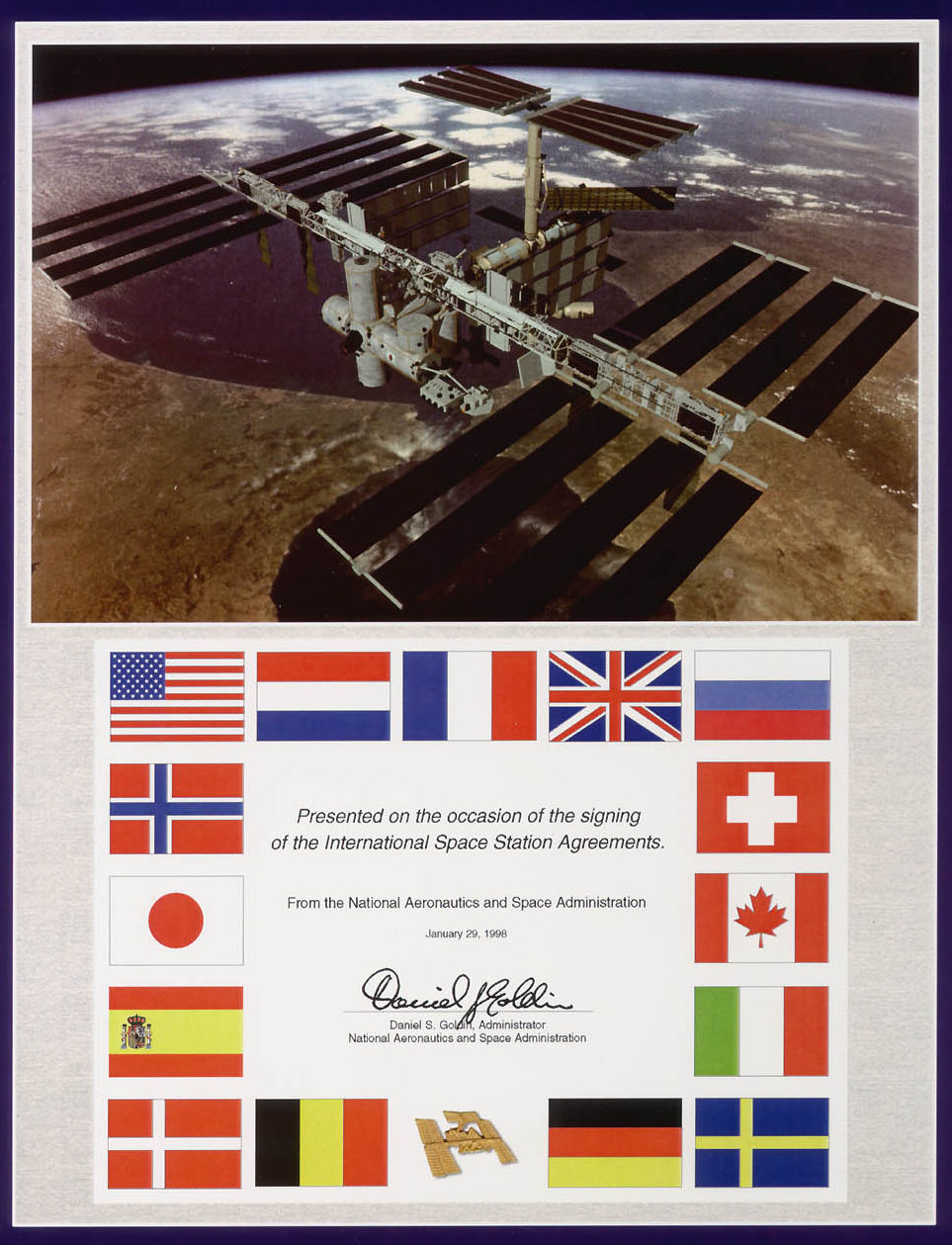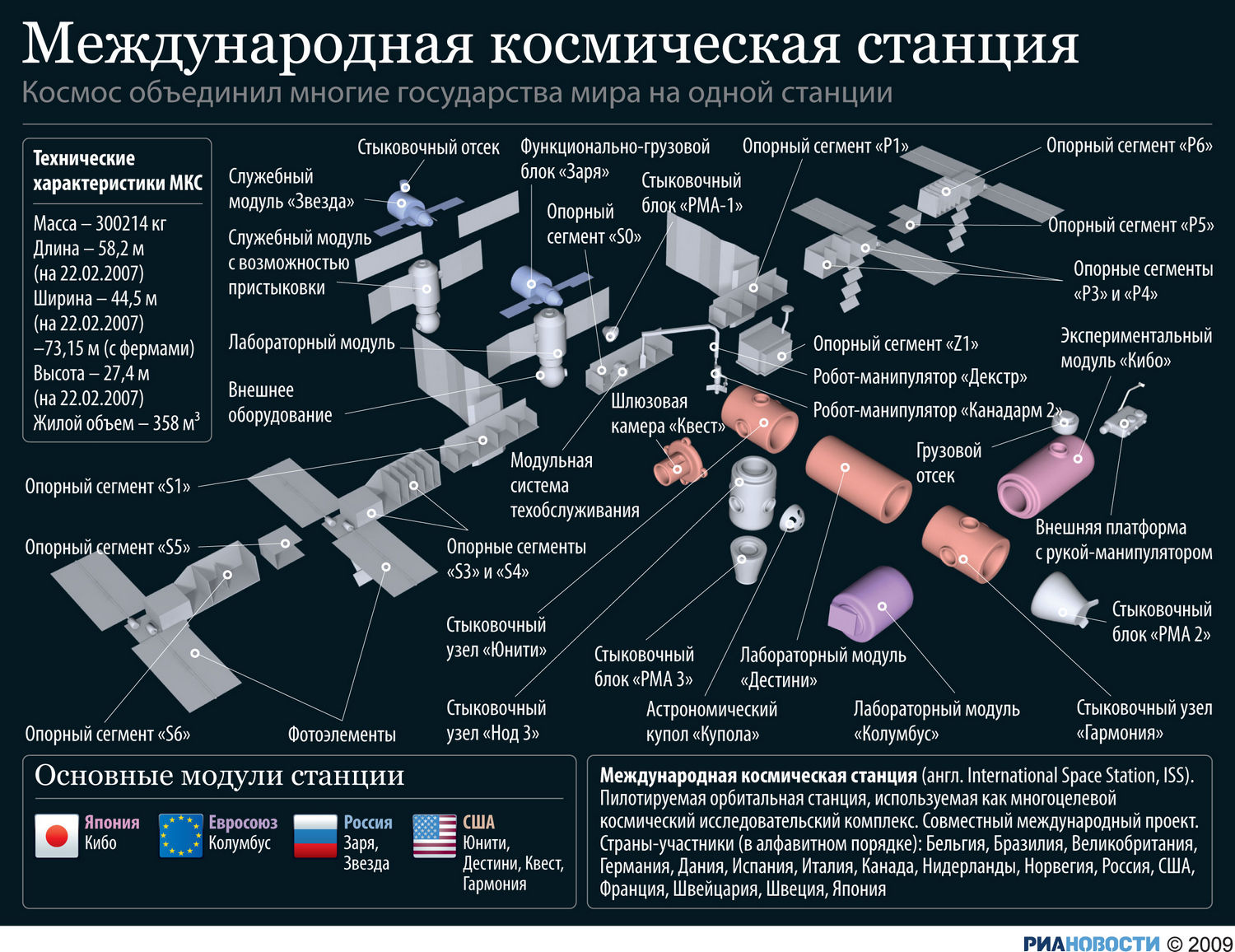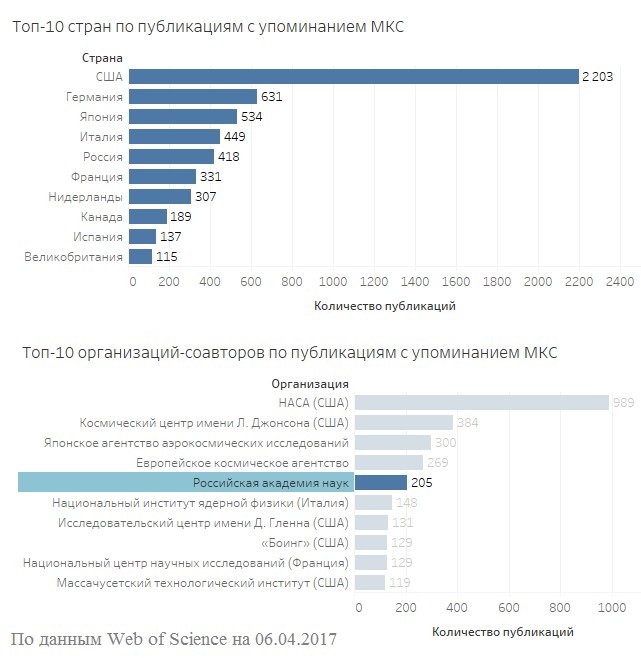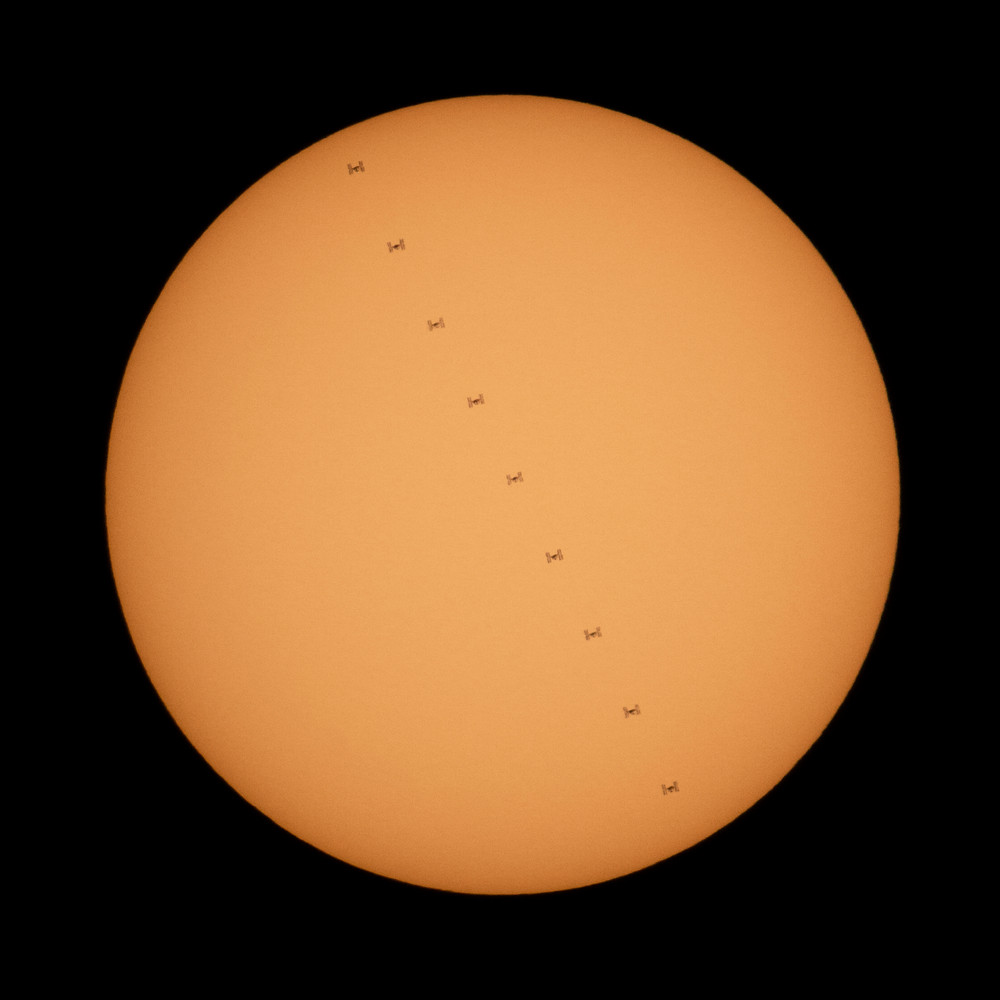The world's largest science project turns 20 years old

On November 19, 1998, the first Zarya module of the International Space Station was launched into orbit - a project involving 14 countries and worth more than $ 200 billion. During this time, the ISS was visited by 398 astronauts. They carried out more than 110 man-days in open space for the process of assembling and maintaining the station. And the total number of experiments that were carried out and continue to be carried out at the station exceeded 1.5 thousand!
Prerequisites of creation
In 1984, in the United States, it was decided to build the international station Freedom in cooperation with Canada, Japan and Europe. However, as the project worked out, it turned out that its implementation would cost too much. At the same time, in Russia, the replacement of the Mir station, the resource of which was coming to an end, was decided to build the Mir-2 station. However, Russia also faced exactly the same problem of insufficient funding for the implementation of its plans.
In this regard, the United States and Russia signed on June 17, 1992 an agreement on cooperation in the field of space research, according to which the Mir-Shuttle project soon began to be implemented. Soon began negotiations on the creation of a unified station, which absorbed the developments in the stations "Freedom" and "Mir-2". The Treaty on the Creation of the ISS was signed on January 28, 1998 between 15 countries: Russia, USA, Japan, Canada and the countries participating in the European Space Agency ( ESA ) of France, Germany, Italy, Spain, Norway, the Netherlands, Belgium, Denmark, Sweden, Switzerland and the UK. The construction of the ISS was planned to be completed by 2010.

Cover contract. You can familiarize yourself with it here .
Unfortunately, even this project was not spared a problem: Austria, Finland and Ireland from the ESA initially refused to participate in the project. Also in early 1999, the United Kingdom came out of the project . On October 14, 1997, NASA and the Brazilian Space Agency signed an agreement that Brazil will develop and manufacture some equipment for the ISS, and in return receive access to laboratories in the US segment and the opportunity to send the Brazilian cosmonaut into orbit. Contractor "Embraer" due to underfunding and failed to produce racks "Espress" on the treaty, so that Brazil came out of the International Space Station cooperation in 2007, while Brazil's first cosmonaut Marcus Pontesstill managed to fly into a 9-day expedition to the ISS in the middle of 2006. During the trial period held in 2010-2013, non-members of the ESA participating countries were not allowed to use the station’s scientific capabilities. But this has not led to an increase in the number of countries participating in the ISS.
Chronology of the assembly
The launch of the Russian Zarya module into orbit on November 20, 1998 ( there is a video from a smaller distance).
18 days after the launch of Dawn, on December 4, 1998, the second module of the Unity station (Node-1) was put into orbit aboard the shuttle Endeavor . After 2 days both modules were docked by a manipulator of the shuttle "Canadarm" and the station for the first time became habitable (the first of its "visitors" were Robert Cabana from NASA's, performing is now the role of Director of Space Center. Kennedy and Sergei Krikalev , who now works supervisor on manned programs of Roscosmos and the president"Cosmonautics Federation of Russia - North-West" ).
July 12, 2000 was withdrawn, and on June 26 the Russian Star module was docked to the ISS. On November 2, 2000, the second historical moment in the life of the ISS came - it became permanently habitable! From that moment to this day in the life of the International Space Station there was no such moment when people would not have been present at it (the full list of expeditions to the station can be found here ).
 Station at the beginning of 2010.
Station at the beginning of 2010. On February 9, 2001, the first scientific 14.5-ton module Destiny was delivered to the station by shuttle Atlantis. Since then, astronauts spend an average of about 36 hoursa week at work on research projects. Later in the same year, the Canadarm 2 manipulator (April 19), as well as the American and Russian lock modules for the spacewalk Quest and Pierce (July 12 and September 15, respectively) were delivered to the ISS . On February 11, 2008, the second scientific 12-ton module “Columbus” was launched to the station , which was launched 4 days before on the shuttle “Atlantis”. And on March 14, 2008, the Japanese scientific 14.8-ton Kibo module was docked to the ISS on the shuttle Endeavor .
The process of assembling the station, as he saw in early 2011: the video is the launch of the module "Science" (MLM), which is still not in the ISS, but there is no inflatable module BEAM , which was launched to the station in 2016.
Unfortunately, the launch of the first Russian scientific 3.5-tonne module “Search” (then called “Small Research Module-2” or MIM-2) as part of the Progress M-MIM2 cargo ship had to wait a little more than a decade - it was launched only on November 12, 2009 on the Soyuz-U carrier rocket . This can be explained by the 2.5-year suspension of shuttle flights after the crash.Columbia in 2003, but only in part (it is also worth noting that after this catastrophe the shuttle missions were limited to missions to build the ISS and repair the Hubble telescope). However, already on May 18, 2010, the Atlantis shuttle to the ISS was docked the second Russian 8-ton scientific module Rassvet (MIM-1), also launched 4 days earlier. Unfortunately, after this, not a single new scientific module was launched to the ISS. And if, according to NASA's plans, all scientific modules have already been launched by this time, then Roskosmos has plans to launch three more such modules: MLM (dubbed "Science" ), NEM-1 and NEM-2.
It is not surprising that at the same time the distribution of scientific results from the ISS is far from being in our favor: there are 320 experiments conducted in the Russian segment of the station (they can be found here ), and according to various data, 1507 or 1534 items. This is confirmed by statistics on scientific publications mentioning the ISS:

In addition to the lack of scientific equipment, the reason for such a huge gap is the difficulty in preparing the entire required package of documents necessary for conducting an experiment on the Russian segment of the ISS, and Roskosmos has been working to simplify for over a yearthis process. The launch of the “Science” module according to the current plans should take place at the end of 2019, but the launch transfer to 2020 (initially planned to be carried out in 2007 ) is not excluded . The NEM-2 module has completely disappeared from the plans, and the launch of the remaining NEM is planned in 2022 . In early October, it became known that all participants of the cooperation of the ISS spoke in favor of extending the operation of the ISS until 2030. If these plans are realized, then Roskosmos will have good chances not only to complete the Russian segment of the station, but also to get scientific results from the commissioning of these two modules to the end of the ISS operation time.
Space junk

Samples after testing from left to right: an aluminum block 10 cm thick after hitting a plastic particle 2.5 cm in diameter at a speed of 6.76 km / s; 3.8 cm aluminum platform after being hit by an aluminum cylinder of 6 mm in diameter and 12 mm in length at a speed of 6.41 km / s; external station electrical cable after hitting an aluminum ball of 3.2 mm in diameter at a speed of 6.9 km / s.
In Roskosmos and NASA have the ability to track objects with dimensions of 10 cm or more. At the same time, station's protective screens are able to withstand hit of objects up to 1 cm.. About 670 thousand objects of space debris in various orbits around the Earth are in the “blind zone” of 1-10 cm. At the same time, despite the fact that new types of classical protection based on composites are being developed for the station, as well as completely exotic projects using lasers , but so far on the planning horizon there are no deadlines for implementing such projects in practice.
This might seem like criminal negligence or even a desire to save cosmonauts on safety, but in reality the probability of encountering a space debris object (despite their impressive number, measured in thousands and even millions) is extremely small. Although cases of the collision of the ISS with small debris periodically occurbut over the 20 years of the station’s existence, no single fact of the hull breakdown by a micrometeorite or a piece of space debris was recorded on it (the body of the ill-fated Soyuz MS-09 ship was probably drilled on the ground ). Therefore, protection is selected based on a reasonable degree of risk minimization.

Monthly number of space debris according to the US space observation network: the explosion of the Ablestar upper stage at an altitude of 800 km - about 300 objects ( 60% of them remained in orbit in 2011); HAPS upper stage explosion - 700 objects; Fengyun 1C test of Chinese anti-satellite weapons - about 3000 objects; Cosmos-2421 satellite explosion - 500 objects;collision of satellites Iridium-33 and Cosmos-2251.
Statistics
Here is the distribution of the astronauts who participated in the long expeditions to the ISS (usually their duration is six months):
| A country | The number of astronauts |
|---|---|
| USA | 54 |
| Russia | 40 |
| Japan | 7 |
| Germany | 3 |
| Italy | 3 |
| France | 2 |
| Canada | 2 |
| Belgium | one |
| Netherlands | one |
| Great Britain | one |
| Total | 114 |
| A country | Number of flights | The number of astronauts | Notes |
|---|---|---|---|
| USA | 263 | 146 | 28 women, 5 tourists, 63 flew twice, 21 three times and 4 four times |
| Russia | 89 | 47 | 1 woman, 16 flew twice, 8 three times, 1 four times and 2 flew 5 times |
| Japan | 14 | 9 | 1 woman, 2 flew twice and 1 thrice |
| Canada | 9 | 7 | 1 woman, 1 tourist, 2 flew twice |
| Italy | 9 | five | 1 woman, 2 flew three times |
| France | four | four | 1 woman |
| Germany | five | 3 | 2 flew twice |
| Belgium | 2 | one | 1 flew twice |
| Netherlands | 2 | one | 1 flew twice |
| Sweden | 2 | one | 1 flew twice |
| Brazil | one | one | - |
| Denmark | one | one | - |
| Kazakhstan | one | one | - |
| Malaysia | one | one | - |
| South Africa | one | one | 1 tourist |
| South Korea | one | one | 1 woman |
| Spain | one | one | - |
| Great Britain | one | one | - |
| Total | 407 | 232 | 34 women, 7 tourists, 88 flew twice, 32 three times, 5 four times and 2 flew 5 times |

Composite image of 9 shots of the ISS transit across the solar disk. October 7, 2018.
A total of 212 spacewalks were carried out from the ISS, with 2 cosmonauts taking part in each of them. The total time spent overboard station counting upon 1 thus has reached was 110 days, 14 hours and 34 minutes. The total costs of all project participants to the station are now approaching the $ 220 billion mark. Over the past 20 years, the station has made more than 110 thousand revolutions around the Earth, thus having covered a distance of 4.8 billion km.
Links
In Russian, some news about the life of the station can be found on the website of the Flight Control Center, but unfortunately, it is updated quite rarely. Another source of news about the ISS can be the blog of Alexander Khokhlov in LiveJournal. Also in this article, you can see a series of videos with his participation about the history of the creation of the ISS, along with their text transcript.
Daily reports from NASA for the ISS in English, you can see here , and additional details about the experiments and the launch - here . Also, additional information can be found in the section of the site Spaceflight101 dedicated to the station.
